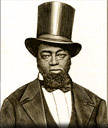







Elijah McCoy (May 2, 1843 – October 10, 1929)
 Born in Canada, Elijah McCoy was an inventor and manufacturer whose African American parents had fled from Kentucky to escape slavery. He opened the Elijah McCoy Manufacturing Co. (1920) and patented an improved air-brake lubricator, one of the some 50 patents he obtained during his lifetime.
Born in Canada, Elijah McCoy was an inventor and manufacturer whose African American parents had fled from Kentucky to escape slavery. He opened the Elijah McCoy Manufacturing Co. (1920) and patented an improved air-brake lubricator, one of the some 50 patents he obtained during his lifetime.
He showed an early talent for mechanical innovations, and in Ypsilanti, MI he developed lubricators for steam engines (1870). In 1882 he moved to Detroit, where he perfected his lubricating cup, still widely used to provide a steady supply of oil to machinery. He opened the Elijah McCoy Manufacturing Co (1920) and patented an improved air-brake lubricator, one of the some 50 patents he obtained during his lifetime.
William Edward Burghardt Du Bois(February 23, 1868 – August 27, 1963)
 Scholar and activist W.E.B. Du Bois was born on February 23, 1868 in Massachusetts. He studied at Harvard University and in 1895 became the first black American to earn a doctorate. He wrote extensively and was the best-known spokesperson for African American rights during the first half of the 20th century. He cofounded the National Association for the Advancement of Colored People (NAACP).
Scholar and activist W.E.B. Du Bois was born on February 23, 1868 in Massachusetts. He studied at Harvard University and in 1895 became the first black American to earn a doctorate. He wrote extensively and was the best-known spokesperson for African American rights during the first half of the 20th century. He cofounded the National Association for the Advancement of Colored People (NAACP).
Samuel Burris (1808–1869)
 Samuel Burris was an African-American member of the Underground Railroad Burris was born in Willow Grove, then a small town in Delaware. Samuel was a free black man in a time when slavery was at its peak. Burris decided to move himself and his family to the safe city of Philadelphia, but from there he would make trips make and forth to the South to free other African Americans from slavery. Burris and his partner John Hunn started working with the Underground Railroad system in 1845. They worked closely together helping free slaves that were escaping from Delaware and Maryland.
Samuel Burris was an African-American member of the Underground Railroad Burris was born in Willow Grove, then a small town in Delaware. Samuel was a free black man in a time when slavery was at its peak. Burris decided to move himself and his family to the safe city of Philadelphia, but from there he would make trips make and forth to the South to free other African Americans from slavery. Burris and his partner John Hunn started working with the Underground Railroad system in 1845. They worked closely together helping free slaves that were escaping from Delaware and Maryland.
Frederick Augustus Washington Bailey(February 1818 – February 20, 1895)
 Abolitionist leader Frederick Douglass was born into slavery in Talbot County, Maryland. He became one of the most famous intellectuals of his time, advising presidents and lecturing to thousands on a range of causes, including women's rights and Irish home rule. Among Douglass' writings are several autobiographies eloquently describing his experiences in slavery and his life after the Civil War.
Abolitionist leader Frederick Douglass was born into slavery in Talbot County, Maryland. He became one of the most famous intellectuals of his time, advising presidents and lecturing to thousands on a range of causes, including women's rights and Irish home rule. Among Douglass' writings are several autobiographies eloquently describing his experiences in slavery and his life after the Civil War.
Zora Neale Hurston (January 7, 1891 – January 28, 1960)
 Zora Neale Hurston was a writer, anthropologist, and folklorist. Born in Notasulga, Alabama. She studied at Howard University (1923–4), Barnard College (1928 BA), and did graduate work at Columbia University. She spent much of her life collecting folklore of the South (1927–31, 1938–9) and of other places such as Haiti (1937–8), Bermuda (1937–8), and Honduras (1946–8), publishing her findings in works including Mules and Men (1935).
Zora Neale Hurston was a writer, anthropologist, and folklorist. Born in Notasulga, Alabama. She studied at Howard University (1923–4), Barnard College (1928 BA), and did graduate work at Columbia University. She spent much of her life collecting folklore of the South (1927–31, 1938–9) and of other places such as Haiti (1937–8), Bermuda (1937–8), and Honduras (1946–8), publishing her findings in works including Mules and Men (1935).
Hurston lived in New York City and held a variety of jobs, such as teacher, librarian, and assistant to Fannie Hurst. She was associated with the Harlem Renaissance of the 1920s, and would later influence such writers as Ralph Ellison and Toni Morrison. She is best known for Their Eyes Were Watching God (1937), a novel celebrating the lives of African-Americans.
Rosa Louise McCauley-Parks (February 4, 1913 – October 24, 2005)
 Civil rights activist Rosa Parks was born in Tuskegee, Alabama. Her refusal to surrender her seat to a white passenger on a Montgomery, Alabama bus spurred a citywide boycott. The city of Montgomery had no choice but to lift the law requiring segregation on public buses. Rosa Parks received many accolades during her lifetime, including the NAACP's highest award.
Civil rights activist Rosa Parks was born in Tuskegee, Alabama. Her refusal to surrender her seat to a white passenger on a Montgomery, Alabama bus spurred a citywide boycott. The city of Montgomery had no choice but to lift the law requiring segregation on public buses. Rosa Parks received many accolades during her lifetime, including the NAACP's highest award.